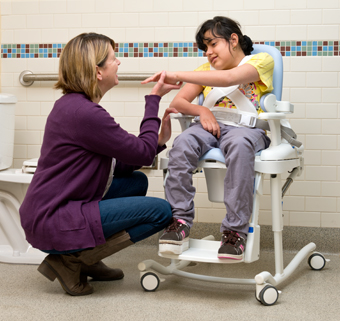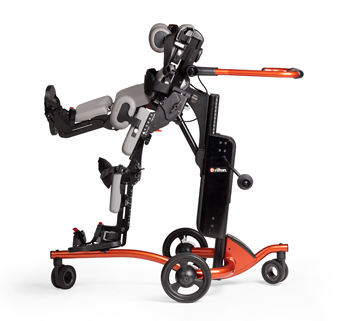Re Evaluating Stretching for Contracture Management
| December 2012Current evidence is challenging our traditional approaches to contracture management in children with cerebral palsy. Following is a brief review of the literature.
Passive stretching, performed manually or with serial casting and positioning techniques, has long been the traditional approach to contracture management in children with cerebral palsy (CP). Behind this approach is the belief that stretching increases the length of a muscle through the addition of sarcomeres in series within that muscle. Increasing muscle length would have positive effects on the surrounding joints. But this has so far only been confirmed in animal studies done in the 1970s. Tabary et al placed the soleus muscles of cats and rodents in shortened and elongated positions and over time observed a corresponding decrease or increase in the number of in-series sarcomeres in these muscles.1 As good and as reasonable as this explanation sounds, it simply has not been shown yet that human muscles respond in this manner to the same stimuli. Perhaps this explains why studies evaluating the effects of passive stretching on improving joint range of motion at this point remain inconclusive.2,3,4
Katalinic et al in their 2011 systematic review effectively sum up the current state of the evidence on stretching for contracture prevention in a population with neurological deficits. Twenty-five studies were evaluated and included forms of stretching done manually, in splints, by serial casting, and positioning. Their findings showed moderate-quality evidence for small and immediate effects of stretching. But the authors attribute this to viscous deformation of the muscle which is only temporary in its effects and therefore not significant. More significantly, high-quality evidence showed that passive stretching has little or no effect, short-term or long-term, on joint range of motion. And of additional interest, an expansion of this same study showed similar results in performing stretches in a population without neurological deficits.4
Next, we look at a study by Shortland et al in regards to stretching for contracture management in children with cerebral palsy. Although there is conflicting evidence on this topic,5,6 Shortland’s study certainly helps us look beyond traditional approaches that are so far ineffective. In assessing the gastrocnemius muscles of children with spastic diplegia,  Shortland et al determined that the fascicle lengths of the muscles were no different from those of typically developing peers.6 This indicates that fixed shortness of the gastrocnemius may not be due to muscle fiber length. Rather, it could be caused by a smaller muscle fiber diameter secondary to muscular atrophy often seen in this population.7 Smaller muscle fiber diameters would take up less space on the aponeurosis of the pennate gastrocnemius, thus reducing the overall length of the muscle belly. If this is the case, then muscle length could be affected through strengthening interventions rather than stretching.
Shortland et al determined that the fascicle lengths of the muscles were no different from those of typically developing peers.6 This indicates that fixed shortness of the gastrocnemius may not be due to muscle fiber length. Rather, it could be caused by a smaller muscle fiber diameter secondary to muscular atrophy often seen in this population.7 Smaller muscle fiber diameters would take up less space on the aponeurosis of the pennate gastrocnemius, thus reducing the overall length of the muscle belly. If this is the case, then muscle length could be affected through strengthening interventions rather than stretching.
And clearly, strengthening, at least in the population of children with cerebral palsy, is showing positive effects. Strengthening, as once thought, does not increase spasticity of a muscle in these children,8,9 but on the contrary improves muscular performance with tie-overs to functional activities.10,11,12,13
We should also consider what the International Classification of Functioning, Disability and Health has to say on this topic. Briefly, the ICF as the newest health classification system, broadens the definition of disability. It emphasizes activities and participation both as the optimal intervention and as the best measure of treatment outcome. Disability is evaluated in the context of every-day functioning. It shifts away from impairment-focused interventions and rather seeks to enable an individual to perform activities that have purpose in their life and within the community. Stretching for contracture management is a passive intervention, and gaining one or two degrees of joint range of motion probably will not have much functional value in the long run. Lesley Wiart, MScPT explains it further:
“From this perspective, the emphasis on joint range of motion changes to a focus on encouraging movement opportunities that enable children with CP to experience a repertoire of movement experiences and participate in enjoyable activities while enhancing their physical fitness. Therapists may want to consider activities such as yoga, Tai Chi, horseback riding, ballet, and swimming programs that allow children to stretch and move within a functional, participatory context. Through such programs, children with CP could become active participants in fitness programs that encourage flexibility instead of passive recipients of therapeutic stretching routines.3”
I couldn’t have said it better.
If you have clinical experience that sheds light on this topic please share it here.
References
1. Tabary JC, Tabary C, Tarieu C, et al. Physiological and structural changes in the cat’s soleus muscle due to immobilization at different lengths by plaster cast. J Physiol. 1972;224(1):231-44.
2. Pin T, Dyke P, Chan M. The effectiveness of passive stretching in children with cerebral palsy. Dev Med Child Neurol. 2006;48:855-62.
3. Wiart L, Darra J, Kembhavi G. Stretching with children with cerebral palsy: what do we know and where are we going? Pediatr Phys Ther. 2008;20:173-78.
4. Katalinic O, Harvey L, Herbert R. Effectiveness of stretch for the treatment and prevention of contractures in people with neurological conditions: a systematic review. Phys Ther. 2011;91(1):11-24.
5. Mohagheghi A, Khan T, Meadows T, et al. Differences in gastrocnemius muscle architecture between the paretic and non-paretic legs in children with hemiplegic cerebral palsy. Clin Biomech. 2007:718-24.
6. Shortland A, Harris C, Gough M, et al. Architecture of the medial gastrocnemius in children with spastic diplegia. Dev Med Child Neurol. 2002;44:158-63.
7. Mockford M, Caulton JM. The pathophysiological basis of weakness in children with cerebral palsy. Pediatr Phys Ther. 2010;22(2):222-33.
8. Dodd KJ, Taylor NF, Damiano DL. A systematic review of the effectiveness of strength-training programs for people with cerebral palsy. Arch Phys Med Rehabil. 2002;83:1157-64.
9. Fowler EG, Ho TW, Nwigwe AI, et al. The effects of quadriceps femoris muscle strengthening exercises on spasticity in children with cerebral palsy. Phys Ther. 2001;81(6):1215-23.
10. Damiano DL, Abel MF. Functional outcomes of strength training in spastic cerebral palsy. Arch Phys Med Rehabil. 1998;79:119-25.
11. Dodd KJ, Taylor NF, Graham HK. A randomized clinical trial of strength training in young people with cerebral palsy. Dev Med Child Neurol. 2003;45:652-57.
12. Fowler EG, Knutson LM, DeMuth SK, et al. Pediatric endurance and limb strengthening (PEDALS) for children with cerebral palsy using stationary cycling: a randomized controlled trial. Phys Ther. 2010;90(3):367-81.
13. Mockford M, Caulton JM. Systematic review of progressive strength training in children and adolescents with cerebral palsy who are ambulatory. Pediatr Phys Ther. 2008;20:318-33.




